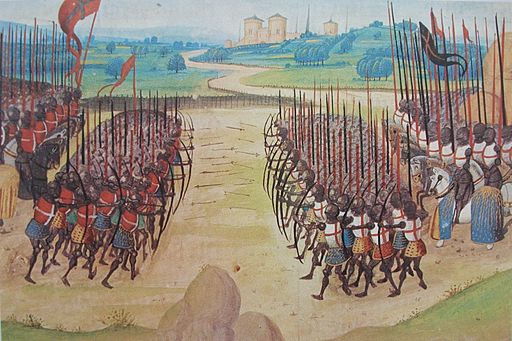
Pick Your Battles or Lose Your Crown
Published in Conflict ResolutionAt some point in every leader’s career, there’s a major battle to be fought.
In 1975, Pepsi-Cola launched the “Pepsi Challenge” during the Cola Wars and won market share from its arch rival Coca-Cola.
Today, Apple and Samsung are battling each other as they raise the stakes for how much technology each company can pack into its mobile devices.
Uber is battling conventional taxi cab companies—and, in some states and countries, courts—to serve riders looking for a better customer experience.
These battles are still being fought.
Another recent battle cost a king his crown.
In November 2011, Ron Johnson joined JC Penney as CEO from Apple. While at Apple, Johnson’s leadership drove Apple’s retail stores to record levels of growth. But at JC Penney, his strategy to make the retailer something its core customers didn’t want caused sales to nosedive. Promises were made and not kept. Morale sagged. Through it all, Johnson continued to live in California and commute by private jet to JC Penney’s Texas headquarters. The stock tanked and the company nearly went under. In less than two years after being hired, Johnson was fired.
Next week is the 600th anniversary of the Battle of Agincourt, and this historical event provides insight for today’s leaders about the essence of strategy, the importance of understanding your troops, and weighing the odds to risk it all.
Lessons from Agincourt
The Battle of Agincourt was a significant English victory in the Hundred Years’ War that was fought on Saint Crispin’s Day on 25 October 1415.
In August 1415, Henry V invaded France after the French refused to honor its debt of paying 1.6 million crowns and ceding ownership of Normandy, Touraine, Anjou, Brittany, Flanders and Aquitaine to the English. The Battle of Agincourt was fought to settle these claims.
Henry’s victory against a numerically superior French army in the northern region of Agincourt ushered in a new era of power for the English in which Henry V married the French king’s daughter and their son became heir to the throne of France as well as England.
Here are three lessons from the Battle of Agincourt today’s leaders would be wise to consider as they fight their own battles.
Pick your battles. Upon invading France in August, Henry conquered the port city of Harfleur but the siege took longer than expected. By October 1415, the English had little food, had marched 260 miles (420 km) in two and a half weeks, were suffering from sickness, and now faced a much larger and better equipped French army. By all accounts, the English were outnumbered three to one. Facing a loss of reputation at home and a huge military challenge in France, Henry had three options. He could pack up his army of 12,000 men and return to England. He could delay the battle with the French for several days, even though doing so would further weaken his tired army and allow more French troops to arrive. Or he could take the fight to the French. Henry chose to fight.
Lesson: Leaders occasionally must take calculated risks with long odds to win the biggest battles.
Inspire your troops. Henry’s decision to fight was based in part on his knowledge of his troops. Outcomes in business, sports, war and life are often determined by a person’s mindset. In William Shakespeare’s depiction of the Battle of Agincourt in his 1599 play Henry V, Henry is portrayed as a man of the people leading a truly English force into battle. Shakespeare’s play emphasizes the important link between the monarch and the common soldiers in the fight. Henry’s understanding of his troops leads him to frame the battle as a just cause and Henry recalls previous victories by English kings over the French while expressing confidence the Battle of Agincourt will end in victory for the English. Henry rouses his men to battle with his famous “band of brothers” speech delivered on St. Crispin’s Day in which he urges those with “no stomach to this fight” to depart for “we would not die in that man’s company.” But those that stay, says Henry, will remember “what feats he did that day” and he invokes a common cause as he calls those who will stay and fight with him, “we few, we happy few, we band of brothers.” Henry led his troops into battle and participated in hand-to-hand combat. The French king, meanwhile, did not participate in the battle.
Lesson: Words can inspire; working alongside your troops to achieve victory are actions that speakspeaks louder than words.
Capitalize on every advantage. Despite the numerical odds against an English victory, Henry had three advantages he leveraged to defeat the French army. First, land on which the battle was fought was framed by dense woodland and also had been recently ploughed. Rain had fallen. The battlefield’s condition meant the French army would be advancing toward the English army through thick mud with no way out on either side. The French monk of St. Denis observed the French troops “were already overcome with fatigue even before they advanced against the enemy.” Second, Henry deployed archers armed with longbows. What the English lacked in numbers they countered with superb organization and superior weaponry. The longbow enabled archers to fire arrows at a great distance with armor-piercing force, killing nearly 5,000 French soldiers in the first wave of the French attack. Third, the large number of French troops actually worked against the French because those in the third rank were so tightly packed they could not use their swords, and those in the first rank that had been killed impeded the progress of the others. Contemporary accounts indicate that the heavily armored French knights who stumbled had difficulty getting back up to fight while some French knights drowned in their helmets.
Lesson: Look for opportunities to turn your opponents’ advantages against them.
In a battle lasting about three hours, Henry’s army of 12,000 defeated a French army of at least 36,000 men, killing between 4,000 and 11,000 men while losing approximately 450 men.
All loss of life is tragic. The lessons of this historic conflict waged 600 years ago provide insight for today’s business leaders who must weigh risks, inspire their troops, and capitalize on even the slimmest of advantages to win battles that will shape the future of their enterprises.
Ready to reset?
Attend my free Accountability webinar: I Did It! to set and achieve your 2021 goals.
- February 17th from 11 AM – 12:30 PM Central Time
- My free webinar will help you:
– Sharpen your personal goals
– Improve time management
– Tackle tough work-related issues
– Support remote workers
Learn More
To dive even deeper into the topic of accountability, I invite you to purchase a copy of my bestselling book, “Accountability: The Key to Driving a High-Performance Culture.”
Become a better leader.
Download my three free e-books.
Free Tips
Sign up to receive free tips on business, leadership, and life.
Get My Latest Book
HOW LEADERS DECIDE
History has much to offer today’s current and aspiring leaders.
Business schools teach case studies. Hollywood blockbusters are inspired by true events.
Exceptional leaders are students of history. Decision-making comes with the territory.



